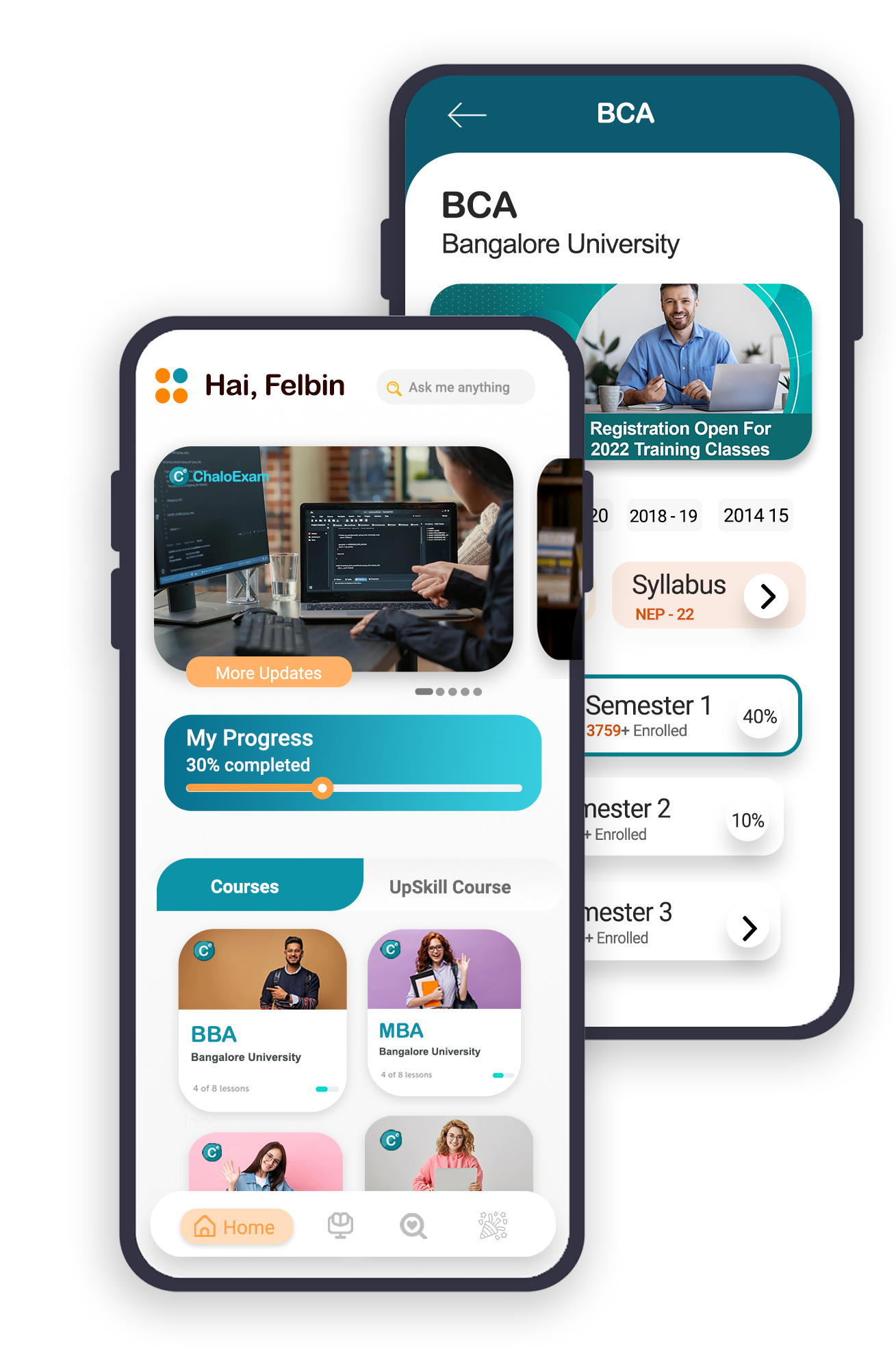Book Free Classes
Download free BBA 1st sem module wise notes, latest solved question papers, previous 5 years question paper till 2021, model question papers, easy notes, exam oriented notes are available on this website chaloexam.com of Bangalore University
Bangalore University 1st Sem BBA Study Materials (New Syllabus )
New Syllabus
Syllabus
1.3 ACCOUNTING FOR BUSINESS
OBJECTIVE:
The objective of this course is to help the students acquire conceptual knowledge of the discipline financial accounting and to impart skills for preparation of financial statements of different undertakings for acquiring practical wisdom
UNIT-1 INTRODUCTION TO ACCOUNTING 06 Hrs Meaning, Book keeping & accounting, Need for accounting, (GAAP) Generally Accepted Accounting Principles Concepts and Conventions, list of Indian Accounting Standards, Ind AS-IFRS (Concept only)
UNIT-2 BASIC ACCOUNTING PROCEDURES 12hrs (i) Double Entry System of Book-Keeping – Golden rules of accounting
(ii) Journal– Books of original entry
(iii) Ledger – Posting – Balancing an account - simple problems on Journal & ledger
UNIT-3 SUBSIDIARY BOOKS 14 Hrs Purchase book – Sales book – Returns books – Bills of exchange –Bills book – Journal proper.- Cash Book – kinds of cash book & Petty Cash Book Imprest system –simple problems
UNIT-4 FINAL ACCOUNTS OF PROPRIETARY CONCERN 14 Hrs Classification of Transaction in to revenue and capital- Preparation of Trial balance & Rectification of errors,- Parts of Final Accounts – Income statement and Balance sheet Final Accounts vertical form only
UNIT: 5: CONSIGNMENT 10 hrs Meaning, Definitions and Features of Consignment-Parties in Consignment – Consignor and Consignee-Differences between Consignment and Ordinary Sale-Special terminologies In Consignment Accounts – Proforma Invoice, Invoice Price, Account Sales, Non-recurring Expenses, Recurring Expenses, Ordinary Commission, Overriding Commission, Del Credere Commission, Normal Loss, Abnormal Loss. Small Problems on Commission and Valuation of Closing Stock Consignment Accounts in the books of Consignor – Problems on preparation of Consignment A/c, Consignee A/c and Goods Sent on Consignment A/c in the books of Consignor.
BUSINESS LAB ACTIVITIES:
(Skill developments /Business lab exercises to be executed with recent accounting software packages like Tally, Quick books, SAP-ERP and maintain record)
Draft a chart relating to companies maintaining IFRS standard
Produce documentary evidence for creating accounting ledgers and groupsent on 3. Prepare a E content on subsidiary books
Develop a E content final accounts any sole trader concern
Develop E-content for a Consignment Agreement
BOOKS FOR REFERENCE:
Dr. S.N. Maheswari, Financial Accounting
Grewal and Shukla, Advanced Accounting
P.C. Tulasian, Pearson Editions, Introduction to Accounting
G
Jain & Narang. Financial Accounting
Accounting Standards - Institute of Chartered Accountants of India 6. Anil Kumar, Rajesh Kumar and Mariyappa, “Financial Accounting”, HPH
G
1.4 ENTERPRISE MANAGEMENT
OBJECTIVE:
The objective of this course is to enable the students to understand the principles of enterprise management of a business entity and its recent trends
UNIT -1 NATURE OF MANAGEMENT AND ITS PROCESS- 14Hrs
Meaning, Nature and Importance of Management, Differences between Management and Administration, Management Approaches; Management Functions-Principles of Management Fayol’s and Taylor’s Principles; Managerial Skills; Task and Responsibilities of Professional Manager
UNIT-2 PLANNING AND ORGANIZATION - 16 Hrs a) Planning -Concept, Features, Importance, Limitations; Planning process; Types of Plans Objectives, Strategy, Policy, Procedures, Method, Rule, Budget; Plan vs Programme- Policies and Procedures; Decision making-Types- Process .
b) Organization-Concept, Features, Importance, Limitations; Organizing process; Types of Organization; Flat organization – relevance- trends , work from home prospects; Centralizations and Decentralization; Delegation; Growth in Organization- Task force
UNIT-3 DIRECTION AND COORDINATION- 12 Hrs a) Direction: Concept, Features, Importance, Limitations; Elements of Direction –Supervision, Motivation and theories of motivation Leadership, Theories and Styles of leadership b) Co-ordination: Concept, Features, Importance, Types and limitations
UNIT-4 CONTROLLING - 08 Hrs Concept, Features, Importance, Limitations; Control Process; Essentials of a Good Control System; Techniques of Control- Traditional and NonTraditional Control Devices; Relationship between planning and controlling
UNIT-5 RECENT TRENDS IN MANAGEMENT 06 Hrs Change Management-Crisis Management-Global practices-International Manager-Quality of work life –Résistance to management- Risk Management-Total quality Management, Kaizan cross culture (Concepts only)
BUSINESS LAB ACTIVITIES :
Develop a Chart on Principles of Management
Prepare Chart on steps involved in decision making
Develop Chart on organisation structire
Construct a Graphic representation of Maslow‟s Theory.
List out recent trends in management
G
BOOKS FOR REFERENCE
Stephen P. Robbins,Management, Pearson
Koontz andO‟Donnell, Management, McGrawHill.
Griffin, Nelson, Manjunath, MGMT and ORGB, Cengage
L M Prasad, Principles of management, Sultan Chand and Sons
V.S.P Rao/Bajaj, Management process and organization, ExcelBooks. 6. T. Ramaswamy : Principles of Management,HPH.
Tripathi& Reddy, Principles of Management. McGraw Hill
R.K Sharma Shashi K Gupta Rahul Sharma: Principles of Management Kalyani Publishers
G
1.5 CORPORATE REGULATIONS
Objective: To create awareness amongst student’s fraternity with the prevalent corporate laws and to nurture administration skills
UNIT-1: INTRODUCTION TO COMPANY 16 Hrs
Meaning and Definition – Features – Kinds of companies as per companies act 2013 – (Meaning only) – Steps involved in formation of company as per companies Act 2013 – Promotion Stage – Meaning of promoter, Position of Promoter and Functions of Promoter- Incorporation stage – Documents required for incorporation- Memorandum of Association and Articles of Association, Certificate of incorporation; Subscription Stage – E-Prospectus, Statement in lieu of prospects and Book Building; Commencement Stage – Documents to be filed, e-filing, Certificate of Commencement of Business.
UNIT-2 : CAPITAL OF A COMPANY 08 Hrs
Share Capital - Meaning of Shares- Kinds of Shares- Debentures and Bonds- Types of debentures and bonds, SEBI guidelines for issue of shares and debentures.
UNIT-3: COMPANY ADMINISTRATION 14Hrs
Key Managerial Personnel- Managing Director, Whole Time Directors, Company Secretary, C-suite executives-CEO, CFO, COO, CTO, CKO, CRO and CIO Chief Financial Officer, Resident Director, Independent Director;(Meaning only) Managing Director- Appointment, Powers, Duties and Responsibilities; Audit committee and its functions Company Secretary- Meaning, Types, Qualification, Appointment, Position, Rights, General duties, Liabilities and Removal or dismissal.
UNIT-4: CORPORATE MEETINGS 08 Hrs
Types of Meetings, Provisions relating to Annual General meeting, Extraordinary General Meetings, Board Meeting as per companies act 2013, Requisites of a valid meeting; Resolutions and kinds of resolution; Preparation of Agenda and minutes. Corporate governance- composition of BODs Cadbury Committee report, SAXEN-OXLEY ACT, Narayamurthy and Narechandra Chandra committee recommendation of corporate Governance.
UNIT-5: WINDING UP OF COMPANIES AND CSR LEGISLATIONS IN INDIA 10 Hrs Meaning- Modes of winding up; Official Liquidator-Powers and Duties; Consequences of Winding up Meaning of CSR, Scope for CSR Activities under schedule VII of the companies Act 2013, Provisions of CSR mandate
BUSINESS LAB ACTIVITIES:
Prepare a chart showing different types of Companies.
Develop e- specimen copy of Memorandum of Association and Articles of Association of any company.
Prepare a chart showing qualifications of company secretary as per companies act 2013 4. Draft a Notice of Company Meetings – Annual, Special, Extraordinary and Board Meetings 5. Prepare a Chart showing functions of liquidator
G
Conduct a case study on CSR initiatives of any one company and submit a case study report
BOOKS FOR REFERENCE (Latest Editions)
N.D. Kapoor, Company Law and Secretarial Practice, Sultan Chand and Sons. 2. M.C. ShuklaandGulshan, Principles of Company Law, S. Chanda and Co. 3. C.L. Bansal, Business and Corporate law, Excel Books.
Chanda, Company Law, Cengage
S.S Gulshan, Company Law, New Age International.
Maheshwari and Maheshwari, Elements of Corporate Laws, Himalaya Publishers 7 Garg K.C , Chawla R.C and Gupta Vijay Company law Kalyani Publishers
G
1.6 BUSINESS MATHEMATICS AND LOGICAL REASONING
Objective: This course aims to equip the students with the mathematical background required for business management and skills of numerical abilities and aptitudes for cracking public service examinations and competitive examinations.
UNIT1: THEORY OF SETS 08 Hrs Theory of Sets – Set Theory- Venn diagram- Applications of set theory- Basic concepts of Permutations & Combinations.
UNIT 2: TYPES OF EQUATIONS AND MATRICES 14 hrs Linear equations - Simultaneous equations (only two variables) Eliminations and substitution method only- Quadratic equations – Factorization and formula method (ax² + bx + c = 0 form only) - Application of equations in business and management.
Matrices: Algebra of Matrices, Inverse of a Matrix and determinants, Problems on linear equations in two variables using Cramer's rule.
UNIT 3: RATIO, PROPORTION, PERCENTAGE, PROFIT AND LOSS 10 hrs
Ratio- Inverse Ratio- Proportion - Properties of Proportions- Direct proportions- Inverse proportions- -Calculation of percentage, regarding marks, population, money, income etc - Profit & loss- Calculation of profit or loss - Calculation of percentage profit or loss - Calculations of cost price and selling price - Total profit or loss while buying and selling different articles at different rates.
UNIT 4: INTEREST & ANNUITIES 14 hrs Simple Interest- Compound interest including half yearly and quarterly calculations - Nominal rat and effective rate of interest - Varying rate of interest- Depreciation - Present value-Net present value - Future value. Annuities - Present value of an annuity-Future value of an annuity-Sinking fund.
UNIT 5: LOGICAL REASONING 10 hrs
Number series - Coding and Decoding - odd man out- Time and work- Analytical Reasoning Relationships - Syllogism
BUSINESS LAB ACTIVITIES:
Divide your class students into pairs and assign each pair a single set concept (such as union, subset, superset, etc.)
Develop Business Problems Matrix
Prepare a Bank Statement using SI and CI.
Develop an Amortization Table for Loan Amount – EMI Calculation.
Develop any two logical puzzles
Take the previous of UPSC, KPSC, Banks, Insurance company, Railway board question papers and solve numerical aptitude and reasoning segments
BOOKS FOR REFERENCE : (Latest edition)
Ayres, Frank Jr. Theory and Problems of Mathematics of Finance. Schaum’s Outlines Series. McGraw Hill Publishing Co.
Dr. Sancheti & Kapoor: Business Mathematics and Statistic, Sultan Chand and Sons.
G
M Raghavachari – Mathematics for Management: An Introduction - Tata McGraw Hill Note 4. R.G.D Allen – Basic Mathematics; Macmillan, New Delhi
Soni, R.S. Business Mathematics. Pitambar Publishing House.
Singh J. K. Business Mathematics. Himalaya Publishing House.
Ranganath: Business Mathematics, GK Publications, Mumbai.
Dr. R.G. Saha & Others – Methods & Techniques for Business Decisions, VBH
Selvaraj, Quantitative Methods in Management, Excel Books
Study Material of the Institute of Chartered Accountants of India (ICAI) Freely Downloadable from the website of the Institute
Accounting for Business

Accounting for Business
Accounting for Business
Enterprises Management

Enterprises Management
Enterprises Management
Corporate Regulations

Corporate Regulations
Corporate Regulations
Business Mathematics and Logical Reasoning

Business Mathematics and Logical Reasoning
Business Mathematics and Logical Reasoning
Join BBA WhatsApp Group
Bangalore University 1st Sem BBA Study Materials (Old Syllabus )
Old Syllabus
Syllabus
1.3 FUNDAMENTALS OF ACCOUNTING
OBJECTIVE
The objective of this subject is to acquaint students with the accounting concepts, tools and techniques influencing business organizations.
Unit 1: INTRODUCTION TO FINANCIAL ACCOUNTING 08 Hrs Introduction – Meaning and Definition – Objectives of Accounting – Functions of Accounting – Users of Accounting Information – Limitations of Accounting – Accounting Principles – Accounting Concepts and Accounting Conventions. Accounting Standards –List of Indian Accounting Standards.
Unit 2: ACCOUNTING PROCESS 10Hrs Meaning – Process of Accounting – Kinds of Accounts – Rules - Transaction Analysis – Journal – Ledger – Balancing of Accounts – Trial Balance – Problems.
Unit 3: SUBSIDIARY BOOKS 10 Hrs Meaning – Significance – Types of Subsidiary Books – Purchases Book – Sales Book – Purchase Returns Book – Sales Return Book – Bills Receivable Book – Bills Payable Book – Cash Book (Simple Cash Book, Double Column Cash Book, Three Column Cash Book and Petty Cash Book) and Journal proper. Bank Reconciliation Statement – Preparation of Bank Reconciliation Statement.
Unit 4: FINAL ACCOUNTS OF PROPRIETARY CONCERN 10 Hrs Preparation of Profit& Loss Account and Balance Sheet(Vertical form).
Unit 5: SINGLE ENTRY SYSTEM 18Hrs Meaning – Features – Types – Merits – Demerits – Differences between single entry and double entry systems – Preparation of Opening Statement of Affairs, Closing Statement of Affairs, Computation of Profit/Loss and Revised Statement of Affairs. Conversion of single entry to double entry system.
SKILL DEVELOPMENT
∙ List out the accounting concepts and conventions.
∙ List out any ten errors disclosed by trial balance
∙ Collect the final accounts of a proprietary concern and present it in vertical form. ∙ Prepare a Bank Reconciliation Statement with imaginary figures
BOOKS FOR REFERENCE
Jawaharlal & Seema Srivastava: Financial Accounting, HPH
R.G Saha, Fundamentals of Accounting, HPH
Dr. S.N. Maheswari, Financial Accounting, HPH
Dr. Venkataraman R. & others, Fundamentals of Accounting, VBH
S Jayapandian: Financial Accounting from Zero,
Grewal and Gupta, Advanced Accounting, Sultan Chand.
S. P Jain and K. L. Narang ; Financial Accounting, Kalyani Publishers.
Soundra Rajan A & K. Venkataramana, Financial Accounting, SHB Publishers. 9. Dr. Alice Mani: Fundamentals of Accounting, SBH.
10
1.4 BUSINESS ORGANISATION AND ENVIRONMENT
OBJECTIVE
The objective is to familiarize the students with aspects of Business Organization and its Environment.
Unit 1: INTRODUCTION TO BUSINESS ORGANIZATION 10 Hrs Meaning of Business – Classification of Business Activities – Industry – Types of Industry – Commerce – Trade – Aids to Trade –Meaning – Advantages and Disadvantages
Unit 2: FORMS OF BUSINESS ORGANIZATION 14Hrs Sole Proprietorship – Meaning – Characteristics – Advantages and Disadvantages. Partnership – Meaning – Characteristics – Advantages and Disadvantages - Types of Partners. Co-operative Society - Meaning – Characteristics – Types – Advantages and Disadvantages.
Unit 3: JOINT STOCK COMPANY 08 Hrs Meaning – Definition – Features – Types of Companies – Formation of a Company.
Unit 4: BUSINESS ENVIRONMENT 14Hrs Meaning and Importance. Dimensions of Business Environment – Political, Economic, Social, Legal, Natural and Technological Environment.
Unit 5: GOVERNMENT AND BUSINESS 10Hrs Meaning and Importance. Impact of Government policy on business and industry with reference to liberalization, privatization and globalization.
SKILL DEVELOPMENT
∙ Draw a Business Tree
∙ Prepare a Partnership deed
∙ Prepare Memorandum and Articles of Association of any company
∙ Discuss the Impact of Globalization on Indian Business and Industry
∙ State the impact of Technology on Indian Business
BOOKS FOR REFERENCE
Dr. Aswathappa: Essentials of Business Environment, HPH.
Francis Cherrunilam : Business Environment, HPH.
Muniraju S.K. Podder – Business Organisation & Environment , VBH
VivekMittall, – Business Environment, Excel Books, New Delhi.
Raj Agarwal – Business Environment, Excel Books, New Delhi.
K. Venkataramana, Business Environment, SHB Publishers.
Dr. Alice Mani: Business Organization & Environment, SBH.
11
1.5 QUANTITATIVE METHODS FOR BUSINESS - I
OBJECTIVE
To provide basic knowledge of quantitative methods and their application to commercial situations and for decision making in business.
Unit 1: NUMBER SYSTEM 04 Hrs Introduction – Natural Numbers - Even Numbers – Odd Numbers – Integers – Prime Numbers – Rational & Irrational numbers, Real Numbers, HCF & LCM ( Simple problems )
Unit 2: THEORY OF EQUATIONS 12Hrs Introduction – Meaning – Types of Equations – Simple, Linear and Simultaneous Equations (only two variables) Eliminations and Substitution Method only. Quadratic Equation – Factorization and Formula Method (ax² + bx + c = 0 form only). Problems on Commercial Application.
Unit 3: PROGRESSIONS 12 Hrs Introduction – Arithmetic Progression - Finding the „nth term of an AP and Sum to nth term of AP. Insertion of Arithmetic Means in given terms of AP and representation of 3 terms of AP. Geometric Progression – Finding nth term of GP – Sum to „n‟th Term of GP – Insertion of Geometric Means in given Geometric Progression and also representation of 3 terms of GP.
Unit 4: MATRICES AND DETERMINANTS 14Hrs Introduction, Meaning, types of matrices – operations of addition, subtraction, multiplication of two matrices – problems, transpose of a square matrix. Determinant of a square matrix- minor of an element, co-factor of an element of a determinant. adjoint of a square matrix, singular and non-singular matrices – inverse of a square matrix – Problems on linear equations in two variables using Cramer‟s rule.
Unit 5: COMMERCIAL ARITHMETIC 14 Hrs Simple interest, Compound interest including half yearly and quarterly calculations, annuities Percentages, bills discounting, concepts of Ratios, duplicate-triplicate and sub-duplicate of a ratio. Proportions, third, fourth and inverse proportion - problems.
SKILL DEVELOPMENT
∙ Calculation of future value of present value.
∙ Calculation of geometric mean i.e, CAGR.
∙ Calculation of EMI, Premium amount.
BOOKS FOR REFERENCE
A.LeninJothi : financial Mathematics, HPH.
Dikshit & Jain : Business Mathematics, HPH
Ranganath: Business Mathematics, GK Publications, Mumbai.
Dr. R.G. Saha & Others – Methods & Techniques for Business Decisions, VBH
R. Selvaraj, Quantitative Methods in Management, Excel Books.
G.R. Veena & Seema: Business Mathematics and Statistics, I.K. Intl
Dr. Sancheti & Kapoor: Business Mathematics and Statistic, Sultan Chand and Sons. 8. Zamarudeen: Business Mathematics, Vikas Publishers.
Saha: Mathematics for Cost Accountants, HPH.
7 Lectures – Quantitative Methods for Business – I, HPH
12
1.6 MANAGEMENT PROCESS
OBJECTIVES:
The objective is to familiarize the students with concepts and principles of Management
Unit 1: INTRODUCTION TO MANAGEMENT 12Hrs Introduction - Meaning, Nature and Characteristics of Management - Scope and functional areas of Management - Management as a Science, Art or Profession - Management & Administration - Principles of management - Social responsibility of Management and Ethics.
Unit 2: PLANNING 08 Hrs Nature, importance and purpose of planning - Planning process, Objectives - Types of plans (Meaning only) - Decision making – importance & steps.
Unit 3: ORGANIZING AND STAFFING 14Hrs Nature and purpose of organization, Principles of organization - Types of organization –Departmentation, Committees - Centralization Vs decentralization of authority and responsibility - Span of Control - MBO and MBE( Meaning only) - Nature and importance of staffing.
Unit 4: DIRECTING AND COORDINATING 14Hrs Meaning and nature of directing - Motivation theories (Maslow‟s, Herzberg, McGregor‟s X & Y theory). Leadership – Meaning -Formal and Informal Leadership – Characteristics - Leadership Styles - Autocratic/Dictatorial - Democratic/Participative, Free reign/Laissez faire Leadership Styles - Communication -Meaning and importance, Barriers to Communication, Types of Communication – Coordination–Meaning, importance and Principles.
Unit 5: CONTROLLING 08Hrs Meaning and steps in controlling - Essentials of a sound control system - Methods of establishing control (in brief).
SKILL DEVELOPMENT
Different types of Organization Charts (structure).
Chart on Staffing.
Graphic representation of Maslow‟s Theory.
Chart on Media of Communication.
Draft Control chart for different industries / business groups.
BOOKS FOR REFERENCE
Appanniah& Reddy, Management HPH.
T. Ramaswamy : Principles of Management, HPH.
Rekha & Vibha – Management Process, Vision Book House.
Koontz & O‟Donnell, Management, McGraw Hill.
L M Prasad, Principles of management, Sultan Chand & Sons
V.S.P Rao/Bajaj, Management process and organization, Excel Books.
13
Karampal : Management Process & Organizational Behaviour, I.K. Intl
Rustum & Davan, Principles and practice of Management.
S V S Murthy, Essentials of Management.
Thomas. N. Duening& John. M. Ivan cevich, Management, Principles and Guidelines, Biztantra Publications.
Tripathi& Reddy, Principles of Management. McGraw Hill
Kandepu : Elements of Functional Administration, HPH
K. Venkataramana, Management Process, SHB Publishers.
Dr. Alice Mani: Management Process, SBH.
Fundamentals of Accounting

Fundamentals of Accounting
Fundamentals of Accounting
Business Organization and Environment

Business Organization and Environment
Business Organization and Environment
Quantitative Methods for Business - I

Quantitative Methods for Business - I
Quantitative Methods for Business - I
Management Process

Management Process
Management Process

previous question papers
- 2020








